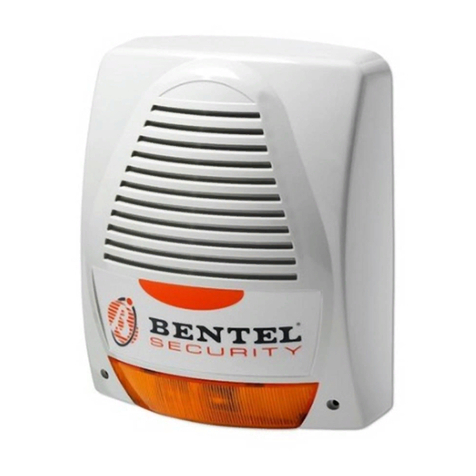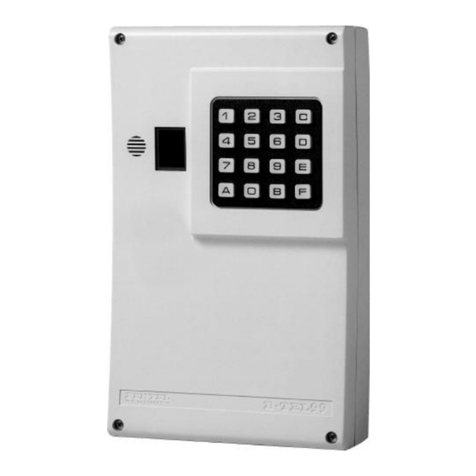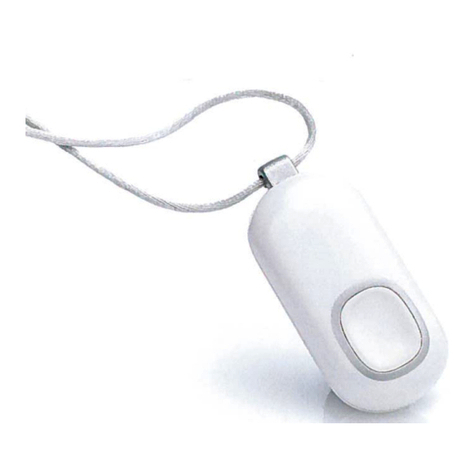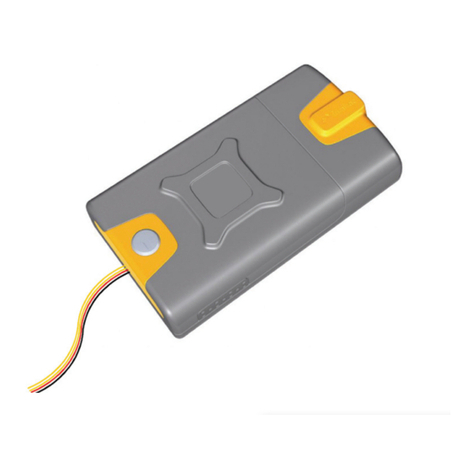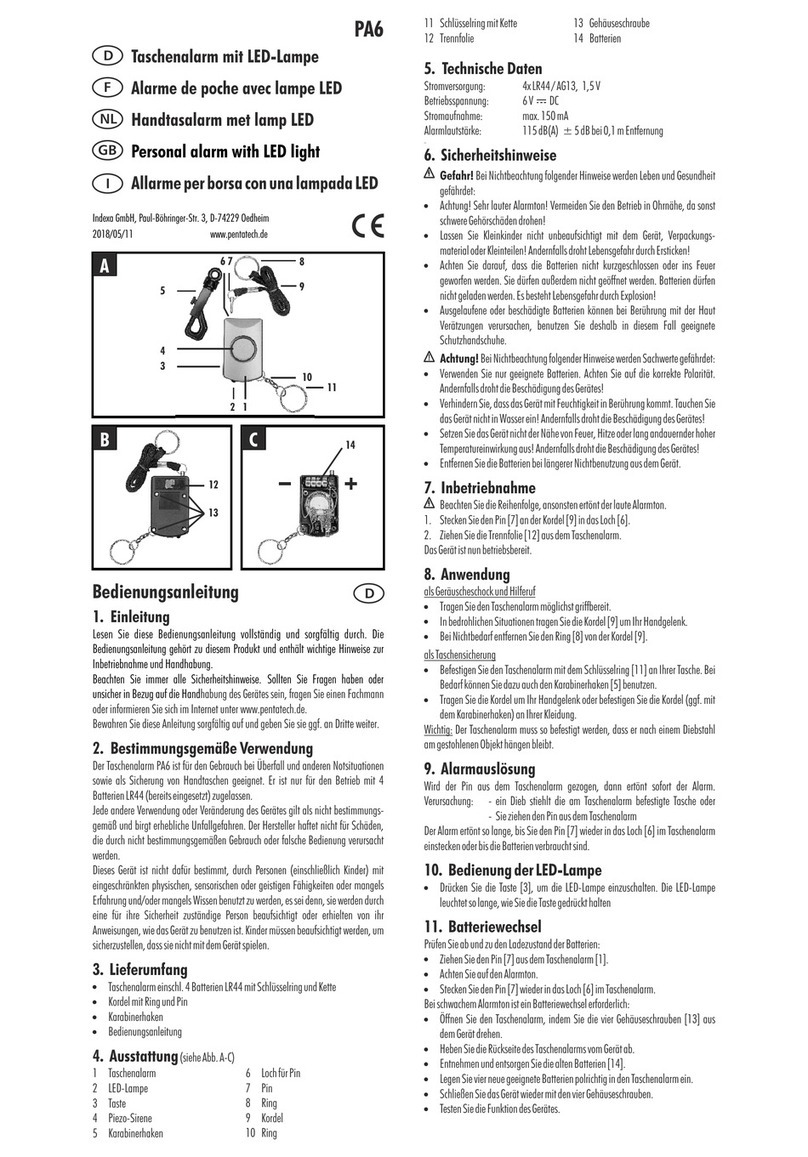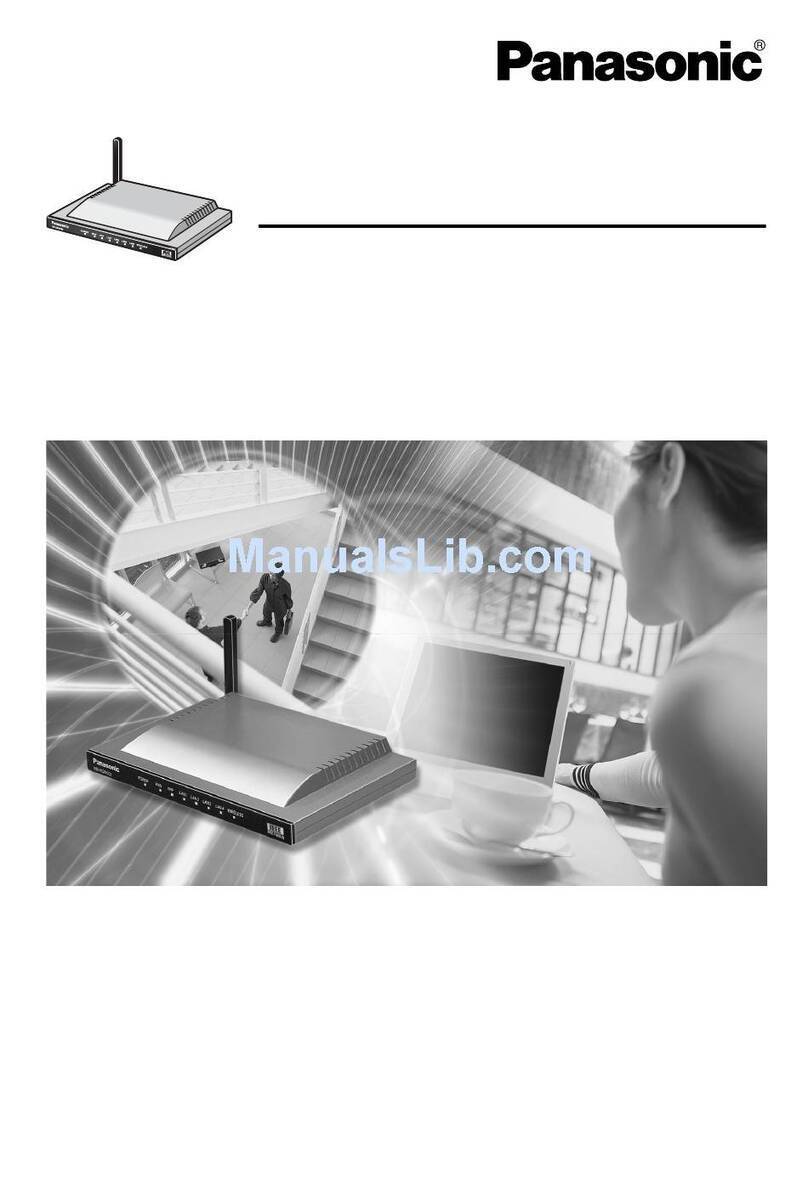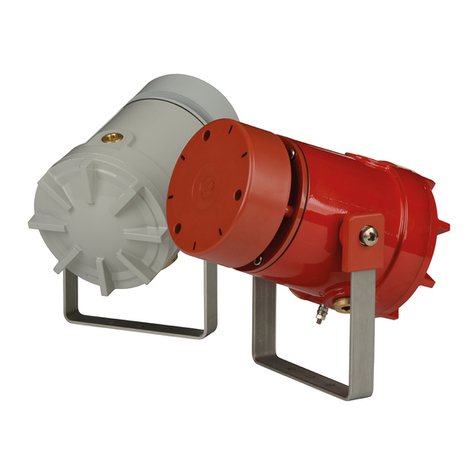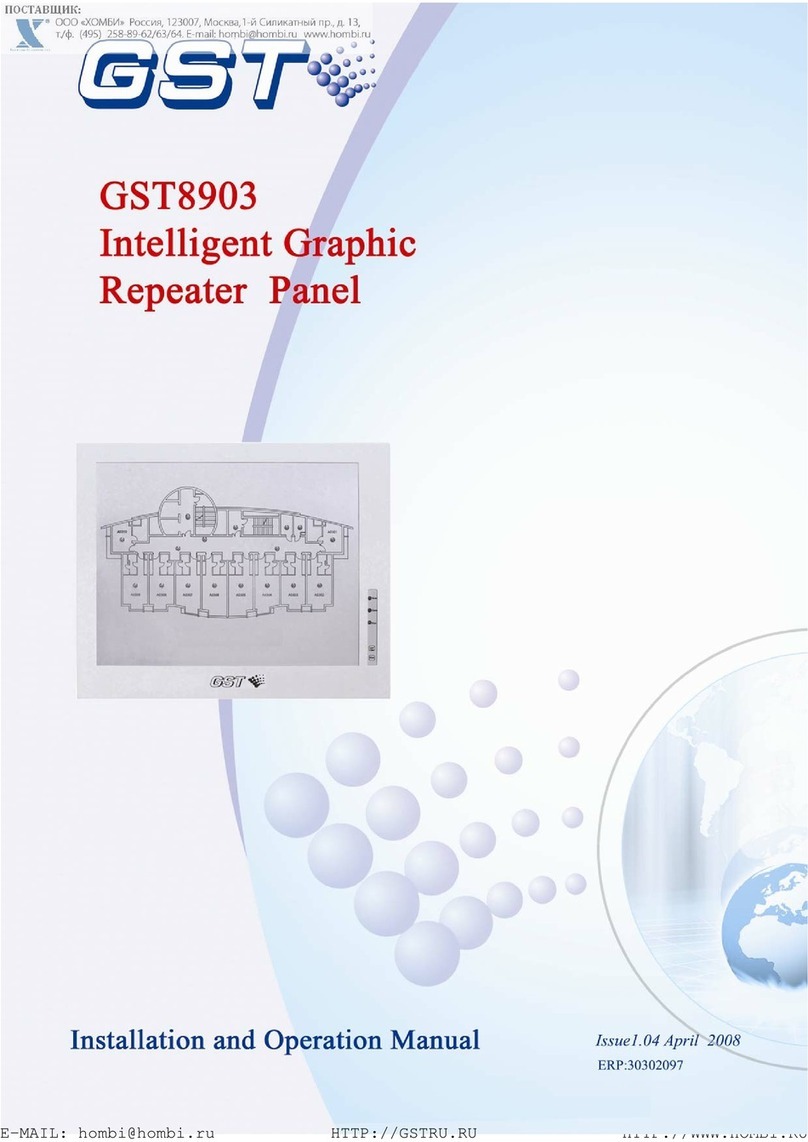Bentel AMB10 User manual

AMB10 - 15 - 20
ITALIANO ISFSLIMRFWL_05_08.doc
1
1. INFORMAZIONI GENERALI
AMB è una barriera a raggi infrarossi per la protezione di porte e finestre con alimentazione a batteria e
trasmissione dell’allarme via radio, che permette un’installazione completamente senza fili.
La barriera è composta di due profili di alluminio, all’interno del quale vengono inseriti i trasmettitori e i ricevitori a
raggi infrarossi, e da due coperture in policarbonato nero. L’intero profilo può essere tagliato a misura, per
adattarsi con precisione all’altezza del vano da proteggere.
L’unità base è formata dalle schede master e slave alle quali possono essere aggiunti raggi di espansione, (AMB-
EX) fino ad un massimo di 3.
I raggi aggiuntivi possono essere posizionati liberamente all’interno del profilo, permettendo così di adattare la
protezione alle esigenze della singola installazione.
La disponibilità di profili di varie misure (da 1 m a 2 m) permette di adeguare la protezione a seconda delle
specifiche esigenze. Il fissaggio tramite viti ed O-Ring dei profili e la particolare sagoma dei tappi garantiscono la
tenuta del fissaggio e consentono l’impiego in ambiente esterno.
2. CARATTERISTICHE TECNICHE
Alimentazione - 3,6 V con 2 batterie al Litio-Cloruro di Tionile formato AA da 2.7Ah
- in alternativa morsettiera per alimentazione 12 VDC o connettore per pacchetto
batteria 3,6 V esterno
Assorbimento - Con 2 raggi 280 µA in standby
- Con 4 raggi 550 µA in standby,
- 10mA durante la trasmissione radio del modulo AMB-TX
Durata batterie
Min 18 mesi con due raggi e funzione di supervisione abilitata
Min 10 mesi con quattro raggi e funzione di supervisione abilitata
ATTENZIONE: la durata delle batterie può ridursi in caso di elevati attraversamenti
giornalieri della barriera, in condizioni sfavorevoli di temperatura o nel caso in cui la
barriera sia esposta alla luce solare diretta.
Tempo di intervento 300 ms o 900 ms, selezionabile tramite dip-switch FUNCTION
Frequenza degli allarmi L’intervallo tra la trasmissione di un allarme ed il successivo è di almeno 10 secondi
Portata infrarosso 7 metri in interno, 5 metri in esterno (montaggio a filo parete)
Lunghezza d’onda I.R. 950 nm
Logica di intervento Interruzione di un raggio o di 2 raggi, selezionabile tramite dip-switch FUNCTION
Uscite - via radio mediante trasmettitore 433Mhz a 5 canali AMB-TX
Tipi di allarme con
modulo radio AMB-TX
INTRUSIONE, FINE INTRUSIONE (solo MASTER)
BATTERIA SCARICA, SUPERVISIONE (disabilitabile tramite jumper), TAMPER
(disabilitabile tramite jumper), FINE TAMPER
Intervallo supervisione 8 minuti
Temperatura di
Funzionamento -20 °C ÷+55 °C
Frequenza trasmissione
radio 433.92 MHz
Portata trasmissione
radio 150 m in ambiente aperto
Tipo codice Univoco per ogni barriera, con algoritmo rolling proprietario
Impostazioni Selezione del tempo di intervento
Selezione della logica di intervento (interruzione 1 o due raggi)
Selezione dei raggi abilitati
Segnalazioni BUZZER per segnalazione dell’allineamento (attivo solo durante la procedura di
allineamento) e dello stato di batteria scarica
LED di trasmissione radio (disabilitabile tramite jumper)
Comandi Tasto di RESET per la messa in funzione della barriera
Tasto di ALIGN/RADIO per l’esecuzione della procedura di allineamento e per il test
della barriera

AMB10 - 15 - 20
ITALIANO ISFSLIMRFWL_05_08.doc
2
3. CARATTERISTICHE PRINCIPALI
•Profilo in alluminio
•Tappo superiore in gomma ed inferiore in ABS con un foro nel fondo protetto da una spugna che consente il
passaggio dell’aria evitando sia fenomeni di appannamento all’interno delle colonne che intrusioni di insetti che
potrebbero arrecare danno alle fotocellule
•Copertura in policarbonato
•Fissaggio a parete tramite viti ed O Ring forniti in dotazione
•Dotazione di quattro coppie di sonde trasmettitore + ricevitore
•Possibilità di espansione fino a 4 coppie di sonde (raggio aggiuntivo cod. AMB-EX)
•Scorrimento sull’apposita guida interna delle sonde Trasmettitore e Ricevitore e fissaggio tramite vite
•Dotazione di tamper antiapertura ed antistrappo (escludibili mediante jumper NO TMP1 e NO TMP2) per ogni
colonna
•Amplificatore fotocellula incorporato con le seguenti caratteristiche tecniche:
- Sistema multiplexato e sincronizzato
- Gestione fino a 4 raggi (8 fasci)
- Uscita MASTER :Trasmettitore radio 5 canali (INTRUSIONE, FINE INTRUSIONE, SUPERVISIONE,
BATTERIA SCARICA, TAMPER)
- Uscita SLAVE (facoltativa):Trasmettitore radio 4 canali (SUPERVISIONE, BATTERIA SCARICA, TAMPER,
FINE TAMPER)
- Facilità di installazione e di allineamento delle sonde grazie ad una semplice procedura di allineamento
Abilitazione dei raggi utilizzati mediante il Dip-Switch “BEAM” a quattro contatti.
- Buzzer per la segnalazione dell’allineamento durante la fase di installazione
- Modalità di funzionamento selezionabile con il Dip-Switch “FUNCTION” come indicato dalla seguente tabella:
Dip 1 Dip 2 Rilevamento intrusione
ON ON Un raggio interrotto per almeno 0,3 secondi
ON OFF Un raggio interrotto per almeno 0,9 secondi
OFF ON Due raggi interrotti per 0,3 secondi
OFF OFF Due raggi interrotti per 0,9 secondi
4. PRINCIPIO DI FUNZIONAMENTO
Le barriere ad infrarossi AMB10-15-20 sono composte da una scheda MASTER ed una SLAVE con a bordo il
raggio 1 e da un raggio aggiuntivo composto da una coppia di sonde trasmettitore TX e ricevitore RX.
Ogni raggio è composto da un fascio ad infrarossi in andata ed uno di ritorno; il MASTER trasmette il segnale allo
SLAVE che, se lo riceve correttamente, lo ritrasmette al MASTER comportandosi come uno specchio “elettronico”.
La barriera può gestire fino a quattro raggi (8 fasci in totale). Per espanderla è possibile acquistare i singoli raggi
con codice AMB-EX.
MASTER SLAVE
TX
TX
RX
RX
TX
RX
TX
RX
RAGGIO
RAGGIO

AMB10 - 15 - 20
ITALIANO ISFSLIMRFWL_05_08.doc
3
All’interruzione di 1 o 2 raggi, a seconda della modalità impostata, la barriera MASTER trasmette l’allarme di
INTRUSIONE. Al ripristino di tutti i raggi abilitati, la barriera MASTER trasmette il segnale di FINE INTRUSIONE. A
seguito del FINE INTRUSIONE, le successive interruzioni dei raggi saranno ignorate per un intervallo di 10
secondi.
Al raggiungimento della soglia di tensione delle batterie di 3V, la barriera trasmette il segnale di BATTERIA
SCARICA. Il segnale viene ripetuto ogni 24 ore, fino alla scarica completa delle batterie.
A intervalli regolari di 8 minuti, la barriera trasmette il segnale di supervisione. E’ possibile disabilitare questa
segnalazione controllando che il jumper “SUPERVISION” sia disinserito per limitare i consumi.
5. MONTAGGIO AMB
5.1 Preparazione e fissaggio
1. Tagliare i profili in alluminio anodizzato nero ed il policarbonato alla misura desiderata (se necessario).
2. Individuare i punti ove eseguire la foratura per il fissaggio dei profili alla parete e per l’introduzione del tamper
antistrappo (se necessario).
3. Forare con punta Ø 4 per il fissaggio e con punta Ø 10,5 per il tamper antistrappo.
4. Posizionare le sonde Trasmettitore TX e Ricevitore RX all’interno dei profili nella posizione desiderata e
fissarle con la vite autofilettante in dotazione (Fig. 1)
5. Inserire il tappo in gomma all’estremità superiore del profilo (Fig. 3).
6. Introdurre la spugnetta nel tappo in plastica in modo da coprire il foro di scarico della condensa. Infilare il
tappo in plastica nel profilo (Fig. 5).
7. Inserire gli azionatori in gomma del tamper antistrappo negli appositi fori, ed inserire le molle sui tamper
antiapertura (Fig. 2). Se non si vuole usare il tamper antistrappo controllare che sia inserito il jumper NO
TMP2. Se non si vuole usare il tamper antiapertura controllare che sia inserito il jumper NO TMP1.
8. Fissare i profili alla parete mediante le viti di fissaggio ed i relativi OR.
9. Sistemare il cavo piatto delle sonde all’interno del profilo e bloccarlo con la molletta fornita in dotazione (Fig. 1).
10. Inserire le batterie al Litio nelle apposite sedi rispettando la polarità o in alternativa collegare una tensione di
alimentazione di 12VDC al morsetto presente sulla scheda. A questo punto la barriera è già funzionante con i
settaggi di default.
11. Procedura di allineamento dei raggi
a) Dopo aver inserito le batterie nella scheda Master e Slave, assicurarsi che i tamper non esclusi tramite
jumper siano azionati. In questa fase per verificare l’allineamento delle sonde è consigliabile escludere
tutti i tamper mediante i relativi jumper “NO TMP”.
b) Premere il pulsante di RESET presente sulla scheda Slave
c) Premere il pulsante di RESET presente sulla scheda Master, il buzzer emetterà 4 Bip.
d) Premere il pulsante ALIGN/RADIO sulla barriera MASTER prima che sia stato emesso il quarto Bip.
e) Se i raggi sono allineati il buzzer emetterà una serie di beep ravvicinati, nel caso di raggi interrotti non emetterà
nessun suono. Nel caso di mancato allineamento, allineare singolarmente i raggi abilitando un raggio alla volta
sul circuito Master e Slave mediante i DIP “BEAM”.
Una volta allineati i raggi verificare che interrompendo un singolo raggio il buzzer smetta di trillare.
f) Verificata la funzionalità dei raggi premere sulla scheda MASTER il pulsante RESET, per uscire dalla modalità
allineamento.
g) Premendo il pulsante ALIGN/RADIO è possibile trasmettere un allarme via radio ad esempio per apprendere il
codice della barriera sul ricevitore.
12. Montare la copertura in policarbonato come indicato nella Fig. 3.
13. Montare la molla in plastica, che serve a ricoprire eventuali irregolarità nel taglio del profilo, sul tappo plastico Fig. 4.
14. Ricontrollare ad installazione ultimata l’allineamento dei raggi
Morsettiera Master/Slave
+12V GND

AMB10 - 15 - 20
ITALIANO ISFSLIMRFWL_05_08.doc
4
5.2 Settaggi e tarature
Abilitare i soli raggi collegati:
a) nelle sonde TX ed RX identificare il raggio (2, 3, 4) con il ponticello a disposizione tenendo conto che ogni raggio
è composto da un fascio di andata ed uno di ritorno (vedi par. 4).
b) nella scheda MASTER, riconoscibile per la presenza del buzzer, porre ad OFF i dip switch “BEAM” dei raggi
impiegati,
DIP BEAM
A
bilitazione ragg
i
Connettore per pacchetto
batterie esterno da 3,6
V
Morsettiera per
alimentazione a
12VDC
Sede batterie AA
3,6V 2,7Ah
Jumpe
r
NO TMP1 antiapertura
Jumpe
r
NO TMP2 antistrappo
Jumper di abilitazione del
segnale di supervisione
Pulsante di Reset
Pulsante d
i
Align/Radio
DIP FUNCTION
selezione della modalità
di rilevamento dell’intrusione
Buzzer
Modulo RADIO
Selezione del
raggio 2, 3 o 4

AMB10 - 15 - 20
ITALIANO ISFSLIMRFWL_05_08.doc
5
c) nella scheda SLAVE porre ad OFF i dip switch “BEAM” dei raggi impiegati,
Selezionare la modalità di rilevamento dell’intrusione con i dip switch “FUNCTION” 1 e 2 del Master e dello Slave
Dip 1 Dip 2 Rilevamento intrusione
ON ON Un raggio interrotto per almeno 0,3secondi
ON OFF Un raggio interrotto per almeno 0,9 secondi
OFF ON Due raggi interrotti per 0,3 secondi
OFF OFF Due raggi interrotti per 0,9 secondi
N.B.: I DIP 3 e 4 al momento sono ininfluenti e sono riservati per applicazioni future.
ON
OF
Raggio
abilitato
1 2 3 4
Raggio
disabilitato
ON
OFF
DIP SWITCH FUNCTION
Modalità
rilevamento intrusione
1 2 3 4
Connettore per pacchetto
batterie esterno da 3,6
V
Morsettiera per
alimentazione a
12VDC
Sede batterie AA
3,6V 2,7Ah
Jumpe
r
NO TMP1 antiapertura
Jumpe
r
NO TMP2 antistrappo
Pulsante di Reset
Pulsante d
i
Align/Radio
DIP FUNCTION
selezione della modalità
di rilevamento dell’intrusione
DIP BEAM
A
bilitazione ragg
i
DIP SWITCH BEAM
Modulo RADIO

AMB10 - 15 - 20
ITALIANO ISFSLIMRFWL_05_08.doc
6
5.3 Segnalazione batteria scarica
Al raggiungimento della soglia di tensione di 3.0 V la barriera MASTER inizia ed emettere un beep ogni 3 ore.
Dopo 3 giorni il periodo di emissione del beep scende a 1 ora.
Dopo altri 3 giorni il periodo di emissione del beep scende a 15 minuti, fino ad esaurimento totale delle batterie. Il beep di
batteria scarica viene emesso comunque ogni volta che i raggi vengono interrotti, con rinnovo del periodo di segnalazione.
5.4 Scheda trasmettitore radio 433 MHz ad innesto AMB-TX
La scheda AMB-TX consente la trasmissione di 6 differenti segnalazioni se innestata sulla barriera MASTER:
- INTRUSIONE
- FINE INTRUSIONE
- SUPERVISIONE
- BATTERIA SCARICA
- TAMPER
- fine TAMPER
La stessa scheda AMB-TX consente la trasmissione di 4 differenti segnalazioni se innestata sulla barriera SLAVE:
- SUPERVISIONE
- BATTERIA SCARICA
- TAMPER
- fine TAMPER
Per ridurre il consumo della barriera, il LED di segnalazione è escludibile disinserendo il jumper J1.
Avvertenza
La barriera rileva il suo attraversamento in caso di interruzione dei fasci per una durata di 300ms o 900ms a
seconda del dip-switch FUNCTION.
In funzione di tale caratteristica l’utilizzo del dispositivo è da intendersi rivolto ad impianti di sicurezza in cui non sia
previsto l’attraversamento della barriera in modo estremamente veloce come ad esempio in applicazioni di controllo
accesso.
La portata della trasmissione radio può essere influenzata dall’installazione della barriera in prossimità di infissi metallici.
Se necessario, la condizione migliore per la trasmissione radio può essere trovata spostando la scheda che
alloggia il trasmettitore radio all’interno del profilo di alluminio, compatibilmente con la desiderata posizione dei
raggi.
J1: jumper per esclusione LED
Utilizzare questo numero seriale a 6 cifre come ESN per configurare
nell’impianto di allarme sia l’elemento Master che quello Slave

AMB10 - 15 - 20
ITALIANO ISFSLIMRFWL_05_08.doc
7
.
Vite di fissaggio
scheda R
X
Jumpe
r
selezione raggio
Connettore pe
r
espansione ragg
i
Morsettiera
alimentazione
12Vd
c
DIP FUNCTIO
N
selezione
modalità allarme
Buzze
r
DIP BEA
M
selezione raggio
Batterie Litio AA
3,6V 2,7Ah
Jumper
esclusione
antistrappo
Tamper
antistrappo
Tamper
antiapertura
Pulsante
Reset
Pulsante
A
lign/Radio
Jumpe
r
esclusione
antiapertura
Connettore pe
r
batteria esterna
3,6
V
Jumper
esclusione led
trasmettitore
Jumpe
r
esclusione
su
p
ervisione
Modulo
trasmettitore
radio ad
innesto
Cavo piatto di
collegamento sonde
Molla bloccaggio
cavo piatto

AMB10 - 15 - 20
ITALIANO ISFSLIMRFWL_05_08.doc
8
Fig. 5
SPUGNA
PASSACAVO
Fig. 4
Fig. 3
Fig. 2
TAMPER
ANTISTRAPPO
MOLLA
TAMPER
TAPPO
IN GOMMA
COPERTURA
TAPPO IN
PLASTICA
TAPPO IN
PLASTICA

AMB10 - 15 - 20
ENGLISH ISFSLIMRFWL_05_08.doc
9
1. INTRODUCTION
AMB is a fully wireless, battery-powered infrared beam barrier for the protection of doors and windows with
alarm radio transmission, that allows a completely wireless installation.
The barrier is made up of two aluminium sections housing the infrared beam transmitters and receivers, closed
by two black polycarbonate covers. The assembled sections may be cut to size and hence perfectly adapted to
the height of the passageway to be protected.
The base unit comprises a master and a slave card which may be expanded to generate additional beams
(AMB-EX) up to a maximum of 8.
The additional beams may be freely positioned inside the sections so as to fully adapt the protection to all
installation requirements. For yet even greater installation flexibility, sections are available in various sizes (from
1 m to 2 m).
Profiles are firmly secured by means of screws and O rings and plugs are especially shaped to always ensure
against any screw or O ring loosening, thus also making for perfectly safe outdoor installation.
2. TECHNICAL SPECIFICATIONS
Power - 3.6 V with 2 AA format, 2.7Ah Lithium-Thionyl Chloride batteries
- alternatively, connection to a terminal strip for 12 VDC powering or to a connector
for 3.6 V off-board battery pack powering.
Consumption - 280 µA with 2 beams in standby
- 550 µA with 4 beams in standby
- 10 mA during radio transmission of the AMB-TX module
Battery life
Min 18 months with 2 beams and supervision function enabled
Min 10 months with 4 beams and supervision function enabled
ATTENTION: in cases where there are an elevated number of daily crossings of the
barrier, or there are unfavourable temperature conditions or the barrier be exposed
to direct sunlight, the battery duration could be reduced.
Tripping time 300 ms or 900 ms, selectable via FUNCTION dip-switch
Alarm frequency an interval of at least 10-seconds between one alarm and the other.
Infrared beam range 7 meters indoor, 5 meters outdoors (wall flush mounting)
Beam wave length 950 nm
Tripping logic 1 or 2 beam break-off, selectable via FUNCTION dip-switch
Outputs via radio with 5-channel, 433 MHz AMB-TX transmitter
Alarm type with AMB-TX
radio module BEAM BREAK-OFF, BEAM RESETTING, FLAT BATTERY, SUPERVISION
(disabled through jumper), TAMPER (disabled through jumper), END TAMPER
Supervision interval 8 minutes
Operative temperature -20 °C ÷+55 °C
Radio transmission
frequency 433.92 MHz
Radio transmission
range 150 m outdoors
Code type Unique for each barrier, with proprietary rolling algorithm
Settings Triggering-time selection
Triggering-logic selection (1 or 2 beam cut-off)
Enabled beam selection
Signals BUZZER indicating beam alignment (enabled only during alignment procedure) and
flat battery status
LED indicating radio transmission (disable by acting on the jumper)
Controls RESET button to get barrier running.
ALIGN/RADIO button to perform alignment and barrier test.

AMB10 - 15 - 20
ENGLISH ISFSLIMRFWL_05_08.doc
10
3. MAIN FEATURES
•Aluminium section.
•Top rubber and bottom ABS plugs with sponge-protected bottom aperture for proper aeration and hence
condensate and insect penetration prevention inside the column to avoid the risk of damaging the photocells.
•Polycarbonate cover.
•Wall mounting by screws and O rings provided.
•Four pairs of transmitter + receiver sensors provided as standard.
•Possibility of expanding to up to 8 pairs of sensors (additional beam code AMB-EX).
•Transmitter and Receiver sensors sliding on appropriate inner guide and securing by means of screws.
•Break-in and tear-off prevention tamper (may be cut out by acting on the NO TMP1 and NO TMP2 jumpers
accordingly) for each column.
•Incorporated photocell amplifier with the following technical characteristics:
−multiplexed and synchronised system;
−up to 4 beam management (8 clusters).
−MASTER Output: 5 channel radio transmitter (INTRUSION, INTRUSION END, SUPERVISION, FLAT
BATTERY, AND TAMPER).
−SLAVE output (optional): 4 channel radio transmitter (SUPERVISION, FLAT BATTERY, TAMPER,
TAMPER END)
−Simple alignment procedure for easy sensor installation and alignment.
−Enabling of beam employed by means of the four-contact “BEAM” dip-switch.
−Buzzer for alignment signalling during installation.
−Operating mode selection by means of the “FUNCTION” dip-switch as specified in the table herewith:
Dip 1 Dip 2 Intrusion detection
ON ON One beam cut-off for at least 0.3 seconds
ON OFF One beam cut-off for at least 0.9 seconds
OFF ON Two beams cut-off for 0.3 seconds
OFF OFF Two beams cut-off for 0.9 seconds
4. OPERATING PRINCIPLE
The AMB10-15-20 infrared beam barriers feature a MASTER and a SLAVE card with beam 1 on board and an
additional beam made up of a pair of TX transmitter and RX receiver sensors.
Each beam is made up of a 2-way (outgoing and incoming) infrared beam cluster; the MASTER transmits the
signal to the SLAVE, which correctly receives it and returns the transmission to the MASTER, essentially
behaving as an “electronic” mirror.
The barrier has a four-beam management capacity (8 clusters in all), which may be expanded, even by one
beam at a time (code AMB-EX when ordering).
MASTER SLAVE
T
X
T
X
R
X
R
X
T
X
R
X
T
X
R
X
BEAM
BEAM

AMB10 - 15 - 20
ENGLISH ISFSLIMRFWL_05_08.doc
11
The MASTER barrier transmits an INTRUSION alarm upon 1 or 2 beam break-off, depending on setting. Upon
all enabled beams being reset, the MASTER barrier transmits the INTRUSION END signal. Following the
INTRUSION END signal any further beam break-off within the next 10 seconds will be ignored.
Upon power of any of the 3 V batteries becoming feeble, the barrier transmits a BATTERY FLAT signal. The
signal is repeated every 24 hours, until battery has goes fully flat.
The barrier transmits a supervision signal every 8 minutes. The signal may be disabled as a power-saving
measure by checking that the “SUPERVISION” jumper is disabled accordingly.
5. AMB MOUNTING
5.1 Setting up and securing
1. Cut the black anodized aluminium sections and polycarbonate cover to size, as required.
2. Locate where to drill the hole for securing the sections to the wall and fitting the rip-off prevention tamper if
required.
3. Drill a hole with a Ø 4 bit for the securing and a Ø 10.5 bit for the rip-off prevention tamper.
4. Fit the TX Transmitter and RX Receiver sensors inside the sections, positioning them as desired and
securing by means of the self-tapping screw provided (Figure 1).
5. Fit the rubber plug onto the top end of the section (Figure 3).
6. Insert the sponge wad inside the plastic plug so as to cover the condensate drain hole. Fit the plastic plug
onto the section (Figure 5).
7. Insert the rip-off prevention rubber tamper triggers into the appropriate holes and fit the springs on the
opening prevention tamper (Figure 2). If the rip-off and/or opening prevention tamper/s is/are not to be
used, check that the NO TMP2 and/or NO TMP1 jumper/s is/are inserted.
8. Secure the sections to the wall by means of the securing screws and O rings.
9. Fit the sensor ribbon-wire inside the section and secure in place by means of the spring provided (Figure 1).
10. Fit the lithium batteries inside the appropriate compartment according to correct polarity or, alternatively,
connect a 12 VDC power line to the terminal on the card. The barrier is now fully operative according to
default settings.
11. Beam alignment procedure
a) After having fitted the batteries in the Master and Slave card, make sure that the tampers that have
not been purposefully cut out by means of the jumper are enabled. To check sensor alignment at this
stage, cutting out of all tampers by means of the corresponding “NO TMP” jumpers is advisable.
b) Press the RESET button on the Slave card.
c) Press the RESET button on the Master card; the buzzer will give out 4 beeps.
d) Press the ALIGN/RADIO button on the MASTER barrier before the fourth beep sounds.
e) If the beams are aligned the buzzer will give out a series of close consecutive beeps and no sound if not. In
case of non-alignment, align each beam separately, enabling one beam at a time on the Master and Slave
circuit by means of the DIP “BEAM” dip-switch.
Once beams are aligned, check that buzzer stops trilling upon one of the beams being broken off.
Lift one of the NO TMP jumpers on the SLAVE card and check that the buzzer stops trilling.
f) Once proper beam operation has been checked, exit alignment mode by pressing the RESET button on the
MASTER card.
g) Press the ALIGN/RADIO button to radio transmit an alarm as an example for receiver to learn the barrier
code.
12. Fit on the polycarbonate cover as shown in Figure 3.
13. Fit the plastic spring onto the plastic plug as shown in Figure 4 to cover any rough cutting edge on the section.
14. Run a final beam alignment check after completing the installation.
Master/Slave Terminal-strip
+12V GND

AMB10 - 15 - 20
ENGLISH ISFSLIMRFWL_05_08.doc
12
5.2 Settings and adjustments
Only enable connected beams, proceeding as follows:
a) identify beam to be employed (2, 3, 4) by means of the jumper provided in the TX and RX sensors, bearing in
mind that each beam is actually made up of a two-way (out-going and in-coming) beam cluster (see section 4 for
further details);
b) set to OFF the “BEAM” dip switches of the beams employed located in the MASTER card, which is identified
by the presence of the buzzer.
Beam enabling DI
P
BEAM dip switch
Off-board 3.6V power pack
connector
12VDC-
p
owering
terminal strip
A
A 3.6V 2.7Ah
batter
y
NO TMP1 opening protection
j
umpe
r
NO TMP2 tear-of
f
p
rotection jumpe
r
Supervision signal
enabling jumper
Reset button
Radio Alignmen
t
Button
A
larm mode selection DIP
FUNCTION dip switch
Buzzer
RADIO module
Beam 2, 3, or
4 selection

AMB10 - 15 - 20
ENGLISH ISFSLIMRFWL_05_08.doc
13
c) set to OFF employed beam “BEAM” dip switches in the SLAVE card.
Select desired alarm mode of intrusion detection with “FUNCTION” 1 and 2 dip switch of the Master and Slave
N.B.: DIPs 3 and 4 are not currently operative and are available for future applications.
5.3 Warning buzzer to indicate flat battery
When the voltage threshold of 3.0 V is reached, the MASTER barrier starts to give out a beep every 3 hours.
After 3 days, the beep will sound every hour.
After a further 3 days, the beep will sound every 15 minutes until the batteries are completely flat.
In any case, the flat battery beep is given out each time that the beams are interrupted, with a consequent renewal of the
signalling period.
Dip 1 Dip 2 Intrusion detection
ON ON one beam break-off for at least 0.3 seconds
ON OFF one beam break-off for at least 0.9 seconds
OFF ON two beams break-off for at least 0.3 seconds
OFF OFF two beams break-off for at least 0.9 seconds
ON
OFF
DIP SWITCH BEAM
Beam
enabled
1 2 3 4
Beam
disabled
ON
OFF
DIP SWITCH FUNCTION
Alarm Triggerin
g
Mode
1 2 3 4
Off-board 3.6V power pack
connector
12VDC-
p
owering
terminal strip
A
A 3.6V 2.7Ah
battery
NO TMP1 opening protection
j
umpe
r
NO TMP2 tear-of
f
p
rotection jumpe
r
Reset button
Radio Alignment
Button
A
larm mode selection DIP
FUNCTION dip switch
Beam enabling DIP
BEAM dip switch
RADIO module

AMB10 - 15 - 20
ENGLISH ISFSLIMRFWL_05_08.doc
14
5.4 AMB-TX 433 MHz Plug-in Radio Transmitter Card
The 433 MHz radio transmitter card has a 6 different signal transmission capacity if plugged onto the MASTER
barrier.
- ALARM
- END ALARM
- SUPERVISION
- FLAT BATTERY
- TAMPER
- TAMPER END
The same AMB-TX card allows the transmission of 4 different signals if plugged onto the SLAVE barrier
- SUPERVISION
- FLAT BATTERY
- TAMPER
- TAMPER END
Disconnect jumper for energy-saving LED cut-out, if desired.
Warning
The barrier detects its crossing if there is an interruption of the beams for a duration of 300 ms or 900 ms
depending on the FUNCTION dip-switch.
Based on this feature, the device is intended for use in security systems where an extremely rapid crossing of the
barrier, such as in access control situations, is not foreseen,
The range of the radio transmission could be affected by the installation of the barrier in proximity to metallic
fittings. If necessary, the best condition for the radio transmission can be found by moving the card with the
radio transmitter inside the aluminium profile, compatibly with the desired position of the beams
J1: LED disabling jumper
Use this 6 digit serial number as ESN to configure both the
master element and the Slave element in the alarm system

AMB10 - 15 - 20
ENGLISH ISFSLIMRFWL_05_08.doc
15
.
RX car
d
securing scre
w
Beam selection
j
umpe
r
Beam expansion
connecto
r
12VDC
p
owerin
g
terminal
DIP FUNCTIO
N
alarm mode
selection switch
Buzze
r
DIP BEAM
selection dip switch
AA 3.6V 2.7Ah
lithium batteries
Tear-off
p
rotection
j
umper cut-out
Tear-off
p
rotection tampe
r
Opening
p
rotection
tamper
Reset push
button
Align/Radio
pushbutton
Openin
g
protection cut-
out
j
um
p
e
r
3.6V off-boar
d
battery connecto
r
Transmitter LED
cut- out jumper
Supervision
cut-out jumpe
r
Plug-in radio
transmitter
module
Sensor connecting
flat cable
Flat cable
securing spring

AMB10 - 15 - 20
ENGLISH ISFSLIMRFWL_05_08.doc
16
Fig. 5
SPONGE
FAIRLEAD
Fig. 4
Fig. 3
Fig. 2
TEAR-OFF
PROTECTION
TAMPER
TAMPER
SPRING
RUBBER
PLUG
PLASTIC
PLUG COVER
PLASTIC PLUG

AMB10 - 15 - 20
FRANÇAIS ISFSLIMRFWL_05_08.doc
17
1. GENERALITES
AMB est une barrière à rayons infrarouges pour la protection de portes et fenêtres avec alimentation par
batterie et transmission d’alarme par radio, permettant une installation totalement sans fils.
La barrière est constituée de deux profils aluminium à l’intérieur desquels sont placés les émetteurs et les
récepteurs à rayons infrarouges et de deux capots en polycarbonate noir. Le profil entier peut être coupé à la
mesure désirée pour qu’il s’adapte avec précision à la hauteur du logement à protéger.
L’unité de base est formée des cartes master et slave possibilité d’expansion jusqu’à 3 rayons (AMB-EX).
Les rayons supplémentaires peuvent être placés librement à l’intérieur du profil, permettant ainsi d’adapter la
protection aux exigences de chaque installation.
La disponibilité de profils de différentes tailles (de 1 m à 2 m) permet d’adapter la protection selon les besoins
spécifiques. La fixation des profils par vis et joints toriques ainsi que la forme particulière des bouchons
garantissent l'étanchéité de la fixation et permettent de l'utiliser en extérieur.
2. CARACTERISTIQUES TECHNIQUES
Alimentation - 3,6 V par 2 batteries au lithium-chlorure de thionyle format AA 2,7 Ah
- en variante, bornier pour alimentation 12 VDC ou connecteur pour pack
batteries 3,6 V extérieur
Absorption - Avec 2 rayons 280 µA en stand-by
- Avec 4 rayons 550 µA en standard
- 10mA pendant la transmission radio du module AMB-TX
Durée batteries
18 mois minimum avec deux rayons et fonction de supervision activée
10 mois minimum avec quatre rayons et fonction de supervision activée
ATTENTION: la durée des batteries peut se réduire en cas de nombre élevé de
franchissements quotidiens de la barrière, dans des conditions défavorables de
température ou si la barrière est exposée à la lumière solaire directe.
Temps de déclenchement 300 ms ou 900 ms, sélectionnable par commutateur DIP FUNCTION
Fréquence des alarmes L’intervalle entre la transmission d’une alarme et la suivante est d’au moins 10
secondes
Portée infrarouge 7 mètres en intérieur, 5 mètres en extérieur (montage au ras du mur)
Longueur d’onde I.R. 950 nm
Logique de déclenchement Coupure d’un rayon ou de 2 rayons, sélectionnable par commutateur DIP
FUNCTION
Sorties - par radio au moyen d’un émetteur 433 Mhz à 5 canaux AMB-TX
Types d’alarme avec
module radio AMB-TX
INTRUSION, FIN D’INTRUSION (seul MASTER)
BATTERIE DECHARGEE, SURVEILLANCE (désactivable par cavalier),
TAMPER (désactivable par cavalier), FIN D’AUTOPROTECTION
Intervalle de surveillance 8 minutes
Température de
fonctionnement de –20 °C à +55 °C
Fréquence de transmission
radio 433,92 MHz
Portée de transmission
radio 150 m en extérieur
Type de code Univoque pour chaque barrière, avec algorithme tournant (rolling) propriétaire
Programmations Sélection du temps de déclenchement
Sélection de la logique de déclenchement (coupure de 1 ou de deux rayons)
Sélection des rayons activés
Signalisations BUZZER de signalisation de l’alignement (il n’est actif que pendant la procédure
d’alignement) et de l’état de charge de la batterie
LED de transmission radio (désactivable par cavalier)
Commandes Touche RESET pour la mise en service de la barrière
Touche ALIGN/RADIO pour exécuter la procédure d’alignement et pour tester la
barrière

AMB10 - 15 - 20
FRANÇAIS ISFSLIMRFWL_05_08.doc
18
3. CARACTERISTIQUES PRINCIPALES
•Profil en aluminium
•Bouchon supérieur en caoutchouc et bouchon inférieur en ABS comportant un trou au fond, protégé par une
éponge permettant le passage de l'air, évitant la formation de buée à l'intérieur des colonnes ainsi que la
pénétration d'insectes pouvant endommager les photocellules
•Capot en polycarbonate
•Fixation murale par vis et joints toriques compris dans la fourniture
•Fourni avec 4 paires de sondes émetteur + récepteur
•Possibilité d’expansion jusqu’à 8 paires de sondes (rayon supplémentaire réf. AMB-EX)
•Coulissement des sondes émetteur + récepteur dans la glissière interne prévue à cet effet et fixation par vis
•Fourni avec autoprotections (tamper) anti-ouverture et anti-arrachage (désactivables par cavalier NO TMP1
et NO TMP2) pour chaque colonne
•Amplificateur de photocellule incorporé ayant les caractéristiques techniques suivantes:
- Système multiplexé et synchronisé
- Pouvant gérer jusqu'à 4 rayons (8 faisceaux).
- Sortie MASTER: Emetteur radio 5 canaux (INTRUSION, FIN D’INTRUSION, SURVEILLANCE, BATTERIE
DECHARGEE, AUTOPROTECTION)
- Sortie SLAVE (facultative):Emetteur radio 4 canaux (SURVEILLANCE, BATTERIE DECHARGEE,
AUTOPROTECTION, FIN AUTOPROTECTION)
- Facilité d’installation et d’alignement des sondes grâce à une simple procédure d’alignement
- Activation des rayons utilisés au moyen du commutateur DIP “BEAM” à quatre contacts
- Buzzer de signalisation de l’alignement pendant la phase d’installation
- Mode de fonctionnement sélectionnable au moyen du commutateur DIP “FUNCTION” comme l’indique le
tableau ci-après:
Dip 1 Dip 2 Détection d’intrusion
ON ON Un rayon coupé pendant au moins 0,3 seconde
ON OFF Un rayon coupé pendant au moins 0,9 seconde
OFF ON Deux rayons coupés pendant 0,3 seconde
OFF OFF Deux rayons coupés pendant 0,9 seconde
4. PRINCIPE DE FONCTIONNEMENT
Les barrières à infrarouges AMB10-15-20 , comprennent une carte MASTER et une carte SLAVE incorporant le
rayon 1 et un rayon additionnel constitué d'une paire de sondes émetteur TX et récepteur RX.
Chaque rayon est constitué d'un faisceau à infrarouges aller et d'un faisceau à infrarouges retour; la carte
MASTER transmet le signal à la carte SLAVE qui, en cas de bonne réception, le retransmet à la carte
MASTER, se comportant ainsi comme un miroir “électronique”.
La barrière peut gérer jusqu'à quatre rayons (8 faisceaux au total); pour l’agrandir, il est possible d’acheter les
rayons individuels AMB-EX.
MASTER SLAVE
T
X
T
X
R
X
R
X
T
X
R
X
T
X
R
X
RAYON
RAYON

AMB10 - 15 - 20
FRANÇAIS ISFSLIMRFWL_05_08.doc
19
Lors de la coupure d’1 ou de 2 rayons, selon le mode sélectionné, la barrière MASTER transmet l’alarme
d’INTRUSION. Au réarmement de tous les rayons activés, la barrière MASTER transmet le signal de FIN
D’INTRUSION. Après le signal de FIN D’INTRUSION, les coupures suivantes des rayons seront ignorées
pendant un intervalle de 10 secondes.
Quand les batteries atteignent le seuil de tension de 3V, la barrière transmet le signal de BATTERIE
DECHARGEE. Le signal est répété toutes les 24 heures jusqu’à ce que les batteries soient complètement
déchargées.
A des intervalles réguliers de 8 minutes, la barrière transmet le signal de surveillance. Il est possible de
désactiver ce signal en contrôlant que le cavalier “SUPERVISION” est déconnecté, pour limiter la
consommation.
5. MONTAGE DE LA BARRIERE AMB
5.1 Préparation et fixation
1. Couper les profils en aluminium anodisé noir et le polycarbonate à la mesure désirée, si nécessaire.
2. Repérer les emplacements des perçages pour la fixation murale des profils et pour l'introduction de
l’autoprotection anti-arrachage, si nécessaire.
3. Percer avec un foret Ø 4 pour la fixation et avec un foret Ø 10,5 pour l’autoprotection anti-arrachage.
4. Poser les sondes émetteur TX et récepteur RX à l'intérieur des profils dans la position voulue et les fixer
avec la vis autotaraudeuse fournie (Fig. 1)
5. Introduire le bouchon caoutchouc à l'extrémité supérieure du profil (Fig. 3).
6. Introduire l'éponge dans le bouchon plastique de façon à couvrir le trou d'évacuation de la condensation.
Enfiler le bouchon plastique dans le profil (Fig. 5).
7. Insérer les actionneurs en caoutchouc de l’autoprotection anti-arrachage dans les trous prévus à cet effet et
insérer les ressorts sur l’autoprotection anti-ouverture (Fig. 2). Si l’on ne veut pas utiliser l’autoprotection
anti-arrachage, contrôler que le cavalier NO TMP2 est enfoncé. Si l’on ne veut pas utiliser l’autoprotection
anti-ouverture, contrôler que le cavalier NO TMP1 est enfoncé.
8. Fixer les profils au mur au moyen des vis de fixation et de leurs joints toriques.
9. Placer le câble plat des sondes dans le profil et le bloquer avec la griffe fournie (Fig. 1).
10. Placer les batteries au lithium dans leurs logements en respectant la polarité ou, en variante, connecter une
tension d’alimentation de 12 VDC à la borne située sur la carte. La barrière fonctionne alors avec les
paramètres par défaut.
11. Procédure d’alignement des rayons
a) Après avoir placé les batteries sur les cartes Master et Slave, s’assurer que les autoprotections
(tamper) non désactivées par cavalier sont actionnées. Dans cette phase, pour vérifier l’alignement
des sondes, il est conseillé de désactiver toutes les autoprotections au moyen des cavaliers
correspondants “NO TMP”.
b) Presser le bouton RESET situé sur la carte Slave
c) Presser le bouton RESET situé sur la carte Master: le buzzer émet 4 bips.
d) Presser le bouton ALIGN/RADIO sur la barrière MASTER avant l’émission du quatrième bip.
e) Si les rayons sont alignés, le buzzer émet une série de bips rapprochés, si les rayons sont coupés, il n’émet
aucun son. En cas de non-alignement, aligner séparément les rayons en les activant un à un sur les circuits
Master et Slave au moyen des commutateurs DIP “BEAM”.
Une fois les rayons alignés, vérifier que le buzzer cesse de sonner si l’on coupe un rayon.
f) Une fois le bon fonctionnement des rayons vérifié, presser le bouton RESET sur la carte MASTER pour
quitter le mode d’alignement.
g) En pressant le bouton ALIGN/RADIO, il est possible de transmettre une alarme par radio, par exemple, pour
apprendre le code de la barrière sur le récepteur.
12. Monter le capot en polycarbonate comme l’indique la Fig. 3.
13. Monter le ressort en plastique, qui sert à recouvrir les éventuelles irrégularités dues à la coupe du profil, sur
le bouchon plastique Fig. 4.
14. Une fois l'installation terminée, recontrôler l'alignement des rayons.
Bornier Master/Slave
+12V GND

AMB10 - 15 - 20
FRANÇAIS ISFSLIMRFWL_05_08.doc
20
5.2 Programmations et réglages
N'activer que les rayons connectés:
a) Sur les sondes TX et RX identifier le rayon (2, 3, 4) avec le cavalier à disposition en tenant compte du
fait que chaque rayon est composé d’un faisceau aller et d’un faisceau retour (voir par. 4).
b) sur la carte MASTER, reconnaissable par la présence du buzzer, mettre sur OFF les commutateurs DIP
“BEAM” des rayons utilisés,
DIP BEAM
A
ctivation rayons
Bornier pour
alimentation
12VDC
Logement
batteries AA 3,6V
2,7 A/h
Cavalier NO TMP1 anti-
ouverture Cavalier NO TMP2
anti-arrachage
Cavalier d’activation du
signal de surveillance
Bouton de Reset
Bouton
A
lign/Radio
DIP FUNCTION selection
du mode de détection de
l’intrusion
Buzzer
RADIO Module
Connecteur pour pack
batteries extérieur 3,6V
Sélection du
rayon 2, 3 ou 4
This manual suits for next models
2
Table of contents
Languages:
Other Bentel Security System manuals
Popular Security System manuals by other brands
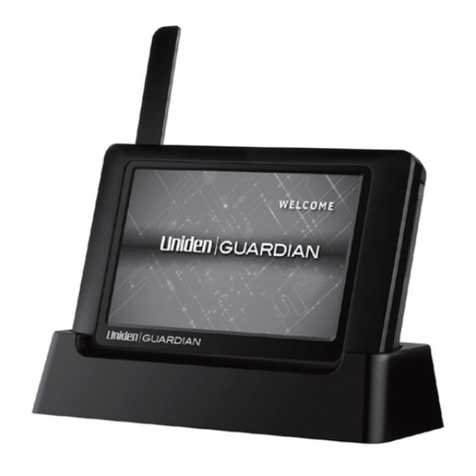
Uniden
Uniden Guardian G455 user guide
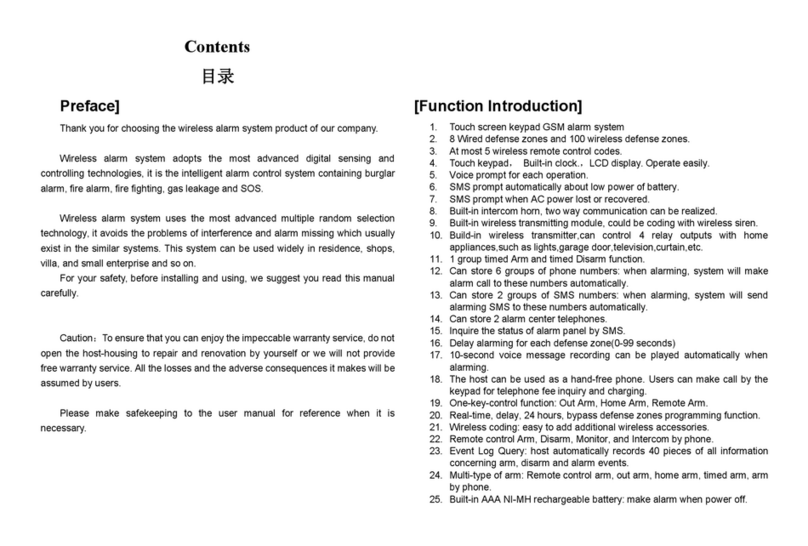
Lightinthebox
Lightinthebox GS-G90E instruction manual
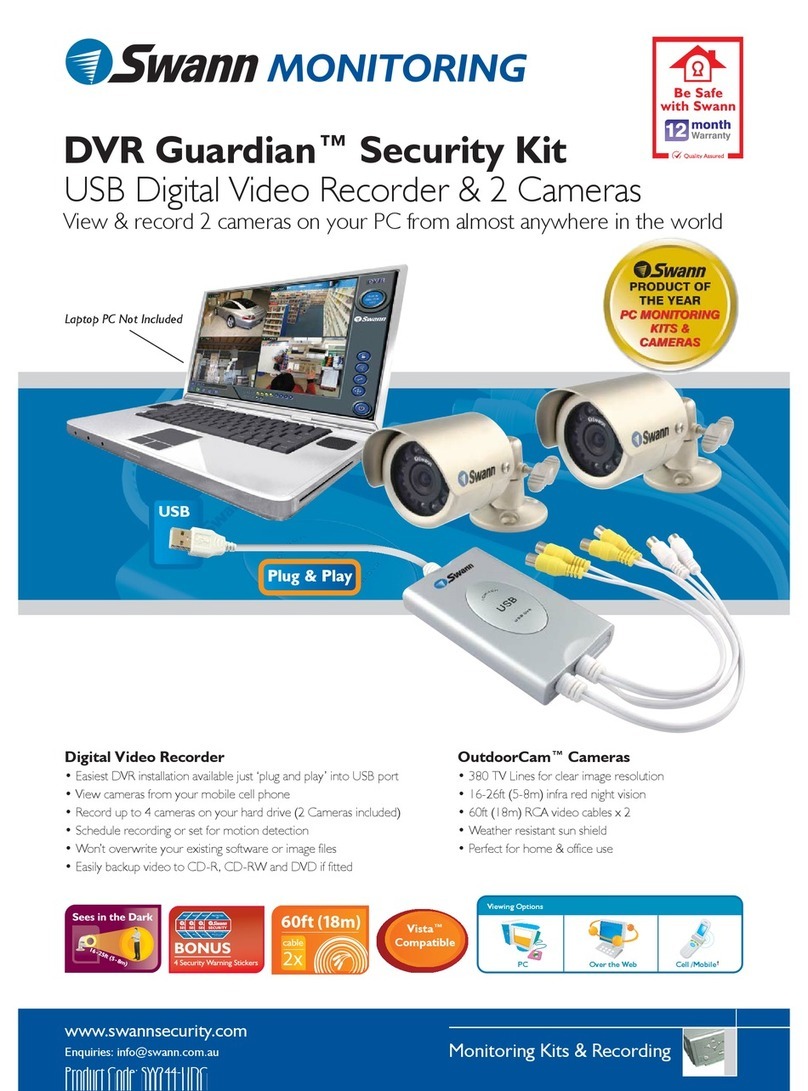
Swann
Swann DVR Guardian SW244-UDC Specification sheet
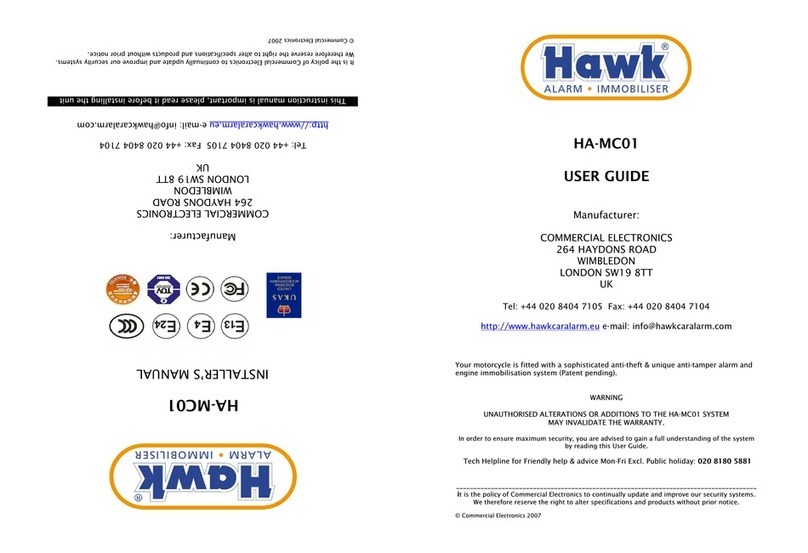
Hawk
Hawk HA-MC01 user guide
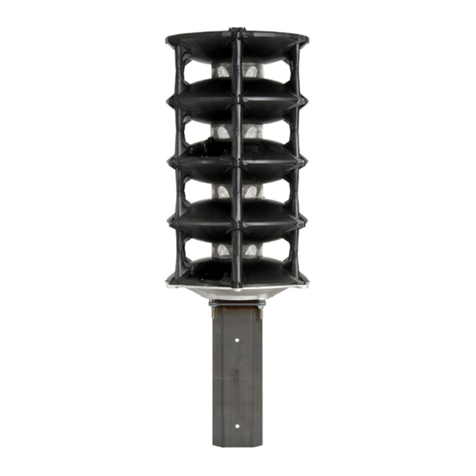
Whelen Engineering Company
Whelen Engineering Company WPS-2900 Series installation manual
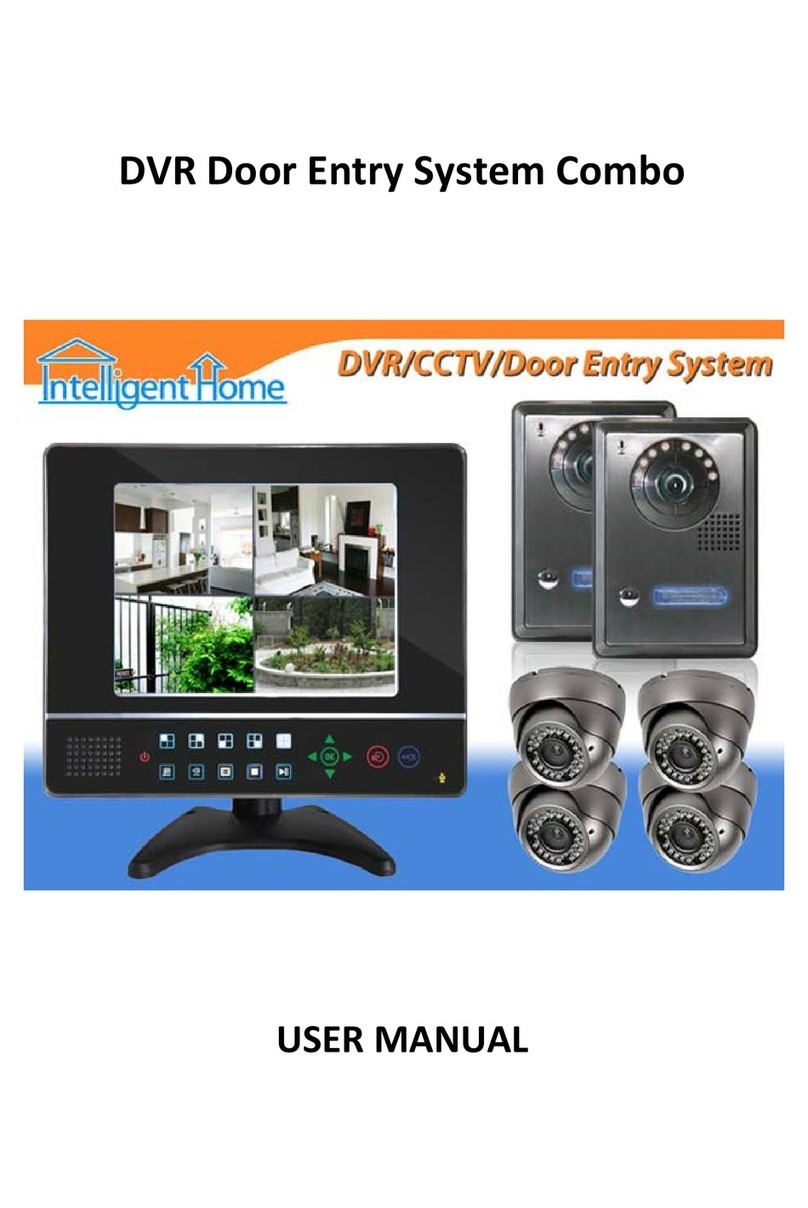
Intelligent Home
Intelligent Home DVR Door Entry System Combo user manual
